“The success of ductwork fabrication lies in its design and execution, ensuring every bend and fold contributes to an efficient and silent air distribution network.”
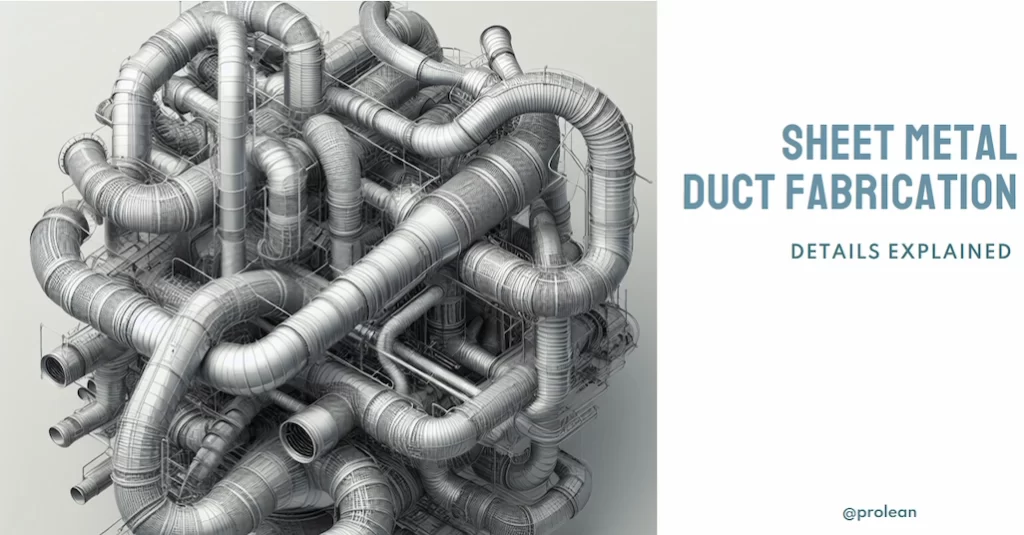
Ducts are common in HVAC and exhaust setups for air distribution, ventilation, and contamination removal. They directly impact the efficiency, cost, and quality of air distribution systems within a space. Meanwhile, duct fabrication sheet metal requires different tools and techniques to achieve the desired outcome.
At the end of the article, we will cover various aspects of ductwork fabrication including, techniques, processes, materials, design considerations, applications, etc.
What are the Sheet Metal Ducts?
A duct refers to a passageway for air in any mechanical system or equipment, while the combination of ducts makes an efficient air distribution network. The ductwork fabrication is prevalent in HVAC systems, exhaust systems, ventilation, and industrial air handling, although its predominant use is in HVAC applications.
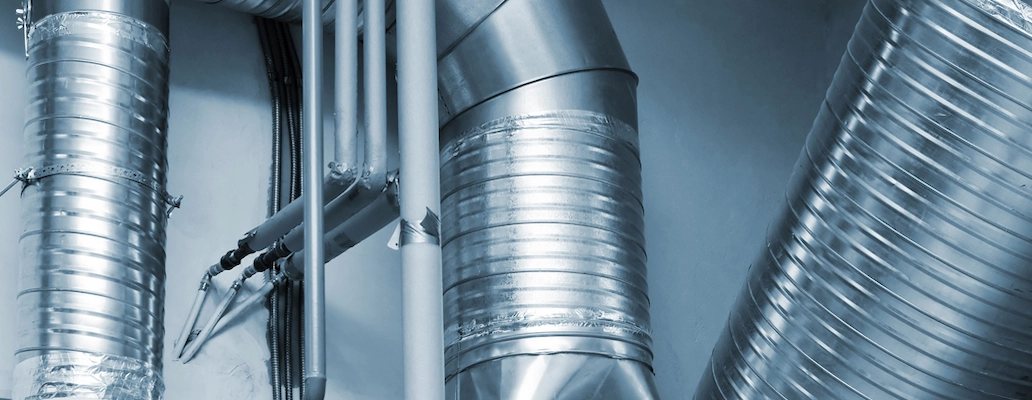
Sheet metal duct work
Different sheet materials are used to handle specific requirements. For instance, stainless steel for high temperatures in industrial exhaust systems and aluminum sheets for HVAC systems.
Next, the process involves precise cutting, sheet metal bending, and assembly to create a duct that fits specific requirements and installation layout. These ducts can be customized to any size or shape, allowing for flexibility in design and installation. The ability to custom-fit ducts to any unique structure or system makes them an optimal choice for an efficient air distribution network.
What are the Different Types and Shapes of Sheet Metal Ducts?
Ducts come in several types and shapes to accommodate diverse installation requirements and airflow dynamics. The type and shape of a duct determine its efficiency in air distribution, space utilization, and overall system design.
Here is the list of common duct types or shapes:
- Rectangular Duct: Ese of fabrication and fitting into buildings or structures. These ducts are ideal for constrained spaces.
- Round Duct: Circular shape, offers reduced pressure drop and better airflow efficiency; used in spaces where air resistance is a concern.
- Oval Duct: It combines the advantages of round and rectangular ducts, suitable for spaces with height restrictions.
- Spiral Duct: Circular shape with spiral construction; offers aesthetic appeal and efficient airflow, commonly used in visible areas.
- Flexible Duct: Made of flexible materials like plastic over a metal wire coil; appropriate for connecting main ducts to air outlets.
Try Prolean Now!
Different Sheet Metals for Duct Fabrication
Different sheet metals offer unique properties, such as corrosion resistance, strength, and thermal conductivity for duct fabrication. Understanding the characteristics and applications of various sheet metals can guide professionals in making informed decisions for effective and long-lasting ductwork.
Table: Different Sheet Metals for Duct Fabrication
| Sheet Metal Material | Description | Example |
| Galvanized Steel | Coated with zinc for corrosion resistance, used commonly in HVAC for its durability, cost-effectiveness, and ease of fabrication. | In residential HVAC systems, balancing cost-efficiency and durability, distributing air effectively. |
| Aluminum | Lightweight, and has excellent corrosion resistance, used in systems requiring flexibility and resistance to moisture and chemicals. | Used in coastal regions for superior resistance to air with high salt content. |
| Stainless Steel | It offers high durability and resistance to extreme temperatures and corrosive substances. | In industrial settings like chemical plants or refineries, withstanding aggressive chemicals and high temperatures. |
| Mild Steel | Known for its strength and versatility, used in heavy-duty industrial applications, can be coated for corrosion resistance. | In large manufacturing facilities for handling high-pressure air flows and industrial wear and tear. |
Sheet Metal Fabrication Techniques for Duct Fabrication
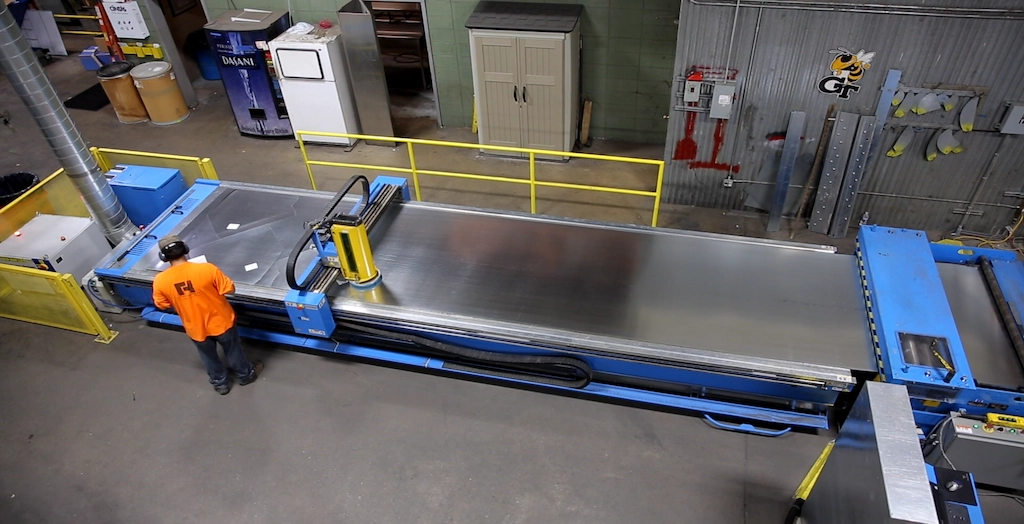
Duct fabrication sheet metal cutting
Ductwork employs various sheet metal fabrication techniques to transform flat metal sheets into functional ducts for HVAC, exhaust, and ventilation systems. Meanwhile, each technique has a specific function in shaping, joining, and surface finishing the sheets to create ducts that meet precise specifications.
1. Sheet Metal Cutting
Cutting is the primary step in duct fabrication to cut the sheet into desired shapes and sizes. Techniques vary from manual cutting tools like shears to more advanced methods like laser and plasma cutting.
Plasma cutting is particularly effective for thicker materials, offering precision and speed. On the other hand, CNC laser cutting is renowned for its accuracy, making it ideal for intricate designs and patterns. The choice of cutting method depends on factors like material thickness, complexity of the design, and production volume.
2. Bending and Forming
Once the metal is cut, it needs to be shaped into ducts. Sheet metal bending and forming are crucial techniques in this stage. Roll-forming machines use brake presses to manipulate the sheets into desired angles and shapes, while brake presses create precise bends at specific angles. Therefore, roll forming is ideal for longer, continuous bends, commonly used in creating circular or spiral ductwork.
3. Sheet Metal Joining
Assembling the cut and bent pieces into ductwork involves various joining techniques, such as riveting, welding, and adhesion. Sheet metal welding offers a strong and airtight seal, ideal for high-pressure systems or where leakage is a concern. On the other hand, riveting or fasteners provide a robust mechanical bond suitable for standard ductwork applications.
4. Finishing and Coating
The finishing touches on ductwork involve applying protective coatings or paint. It enhances the duct’s appearance and offers additional protection against corrosion, moisture, or chemical exposure. Some common duct finishing techniques are powder coating and electroplating.
5. Sealing and Insulation
To enhance the duct’s efficiency, sealing and insulation techniques are applied. Sealing joints and seams with mastic or tape prevents air leaks and maintains the system’s efficiency. For example, insulating the ductwork (typically with fiberglass or foam) minimizes heat loss and controls condensation in an HVAC system.
The Sheet Metal Duct Fabrication Process
Fabricating ductwork from sheet metal involves several key steps, each requiring precision and expertise to ensure the final product meets the required standards and specifications. From designing to post-processing, each stage of the duct fabrication process plays a crucial role in the performance and longevity of the duct system.
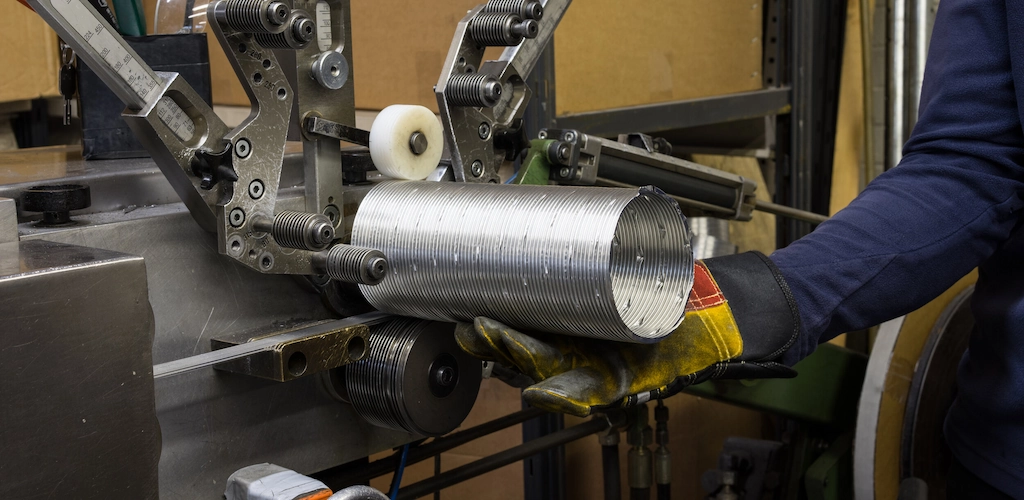
Duct forming
Table: Steps Involved in Sheet Metal Duct Fabrication Process
| Step | Description |
| Material Selection | Choose appropriate sheet metal based on environmental conditions, system requirements, and budget. |
| Design and Layout Planning | Create a detailed CAD design considering custom fittings and optimizing airflow to meet specific needs. |
| Cutting and Shaping | Precisely cutting and shaping the metal into ducts using tools like shears, plasma cutters, or laser cutters. |
| Assembly and Joining | Assembling and joining the pieces using techniques like riveting, welding, or using specialized connectors. |
| Finishing and Quality Control | Applying protective coatings or paint and conducting quality control checks to ensure it meets all specifications and standards. |
Try Prolean Now!
Design Considerations for a Sheet Metal Duct
The sheet metal duct design is fundamental to the efficiency, functionality, and longevity of HVAC, exhaust, and ventilation systems (Basically, for its applications).
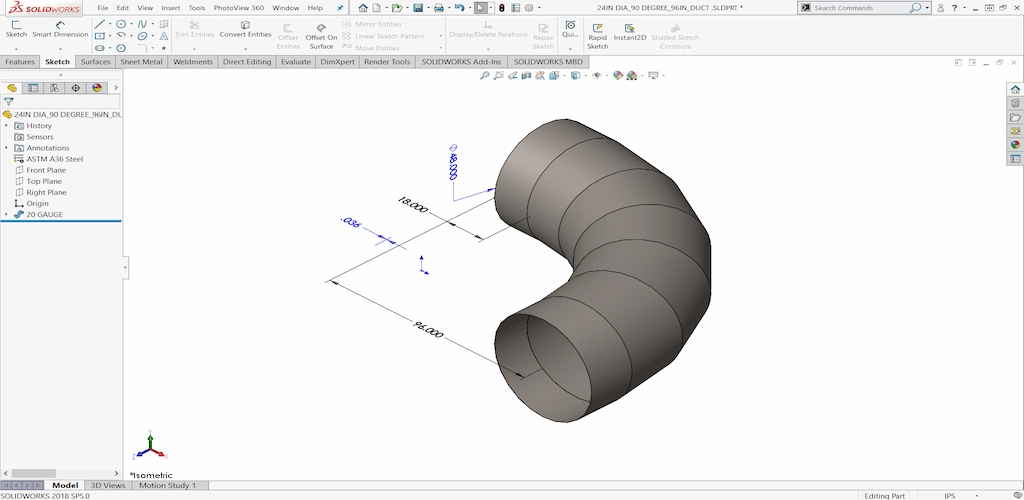
Sheet metal duct design
A well-thought-out design ensures optimal airflow, energy efficiency, noise reduction, and overall system effectiveness. So, it is essential to consider factors like duct type, size, shape, and layout, all of which directly impact the performance. Furthermore, here are the six major sheet metal duct design considerations;
1. Duct Size and Capacity
The sizing of ducts influences airflow efficiency and system balance. Incorrectly sized ducts can lead to pressure losses, uneven heating or cooling, and increased energy consumption. So, determine the size based on the air volume requirements of the space, with calculations considering factors like room size, usage, and system capacity.
2. Shape and Layout
The shape and layout of ducts impact the efficiency of airflow and the ease of installation. Rectangular ducts are preferred in constrained spaces, whereas round ducts offer better airflow with less friction loss. Moreover, The layout needs to minimize bends and turns to reduce resistance and noise.
3. Insulation and Sealing
Proper insulation and sealing of ducts are essential to prevent energy loss and maintain desired temperatures. Insulation is critical in unconditioned spaces. Subsequently, sealing ensures no air leaks occur in the system.
4. Noise Consideration
The ductwork design must consider noise levels. It involves selecting duct sizes and layouts that minimize air turbulence and using insulation to dampen sound. For example, special care is taken in hospital duct design to keep the noise level minimal.
5. Compliance with Standards
Adherence to industry standards and building codes is essential in duct design. It ensures safety, efficiency, and compatibility with HVAC equipment and building structures.
6. Energy Efficiency
Energy-efficient duct design is increasingly important to reduce operational costs and environmental impact. It includes optimizing duct layout, material, and insulation to minimize energy loss.
How much does Duct Fabrication Cost?
The cost of fabricating ducts varies significantly based on diverse factors like material type, size, thickness, length, and fabrication techniques. So, these factors determine the overall cost of sheet metal duct fabrication.
Furthermore, material choices like aluminum are often popular because of its durability and suitability for application, while size, thickness, and length are decided by the system’s airflow requirements and space constraints. Next, how many fabrication techniques are involved also contributes to the cost as they require different levels of labor and expertise.
Example of Cost Estimation for an Aluminum Rectangular Duct
Let’s understand the duct fabrication cost by dissecting a real-world example of an aluminum rectangular duct used in an HVAC system.
- Size: 24 inches x 12 inches (width x height)
- Thickness: 0.032 inches (standard for aluminum ductwork)
- Length: 10 feet
- Fabrication Techniques: Cutting using a shear machine, bending on a brake press, and joining using rivets and sealant.
Table: Cost Estimation Example of Aluminum Rectangular Duct Fabrication
| Cost Component | Details | Estimated Cost |
| Material Cost | Assuming Aluminum sheet metal at $3 per square foot, for a duct of 40 square feet | $120 |
| Labor Cost | Labor and Equipment cost for cutting, bending, and assembling at $50 to $100 per hour( for 2 hours) | $100 – $200 |
| Additional Supplies Cost | Costs for sealants, rivets, and other supplies | $20 |
| Total Estimated Cost | Total cost for fabricating a 10-foot-long aluminum rectangular duct | $240 – $340 |
(Note: This table provides an example of cost breakdown. However, always consult with a manufacturing professional before estimating the cost for your duct fabrication sheet metal project.)
What are the Applications of Sheet Metal Ducts?
Sheet metal ducts are used in heating, ventilation, and air conditioning (HVAC) systems. They serve as vital conduits for distributing air throughout the building and maintaining indoor air quality, temperature control, and overall comfort.
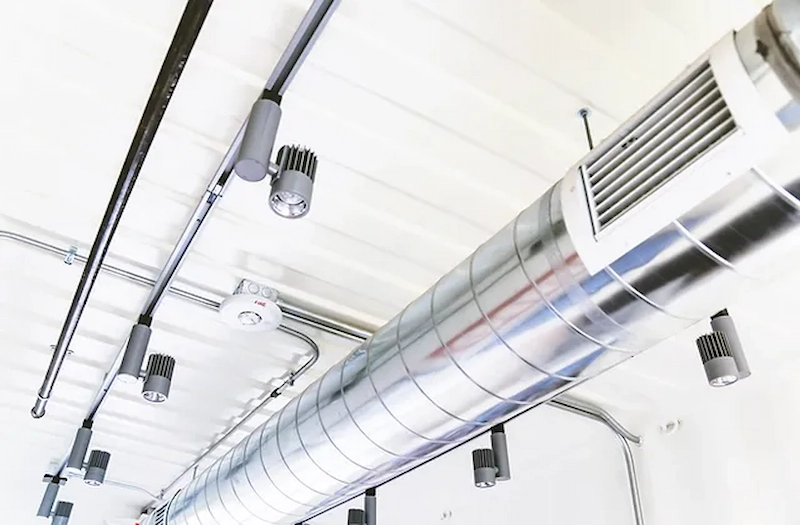
HVAC duct’
Moreover, sheet metal ducts are extensively popular in industrial and manufacturing settings for ventilation and exhaust. They play a critical role in removing harmful gases, fumes, and dust from work areas, thereby protecting the health and safety of workers. However, these ducts should withstand harsh conditions and aggressive substances to ensure long-term reliability and performance.
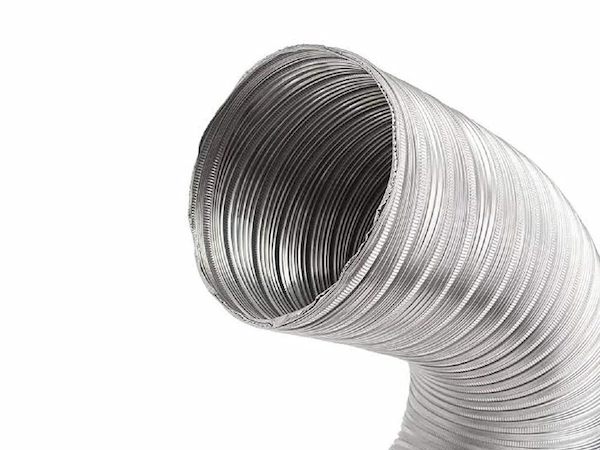
Exhaust duct
In addition to HVAC and industrial uses, sheet metal ducts find applications in specialized areas, such as kitchen exhaust systems in the culinary and hospitality sectors. These ducts are responsible for efficiently extracting smoke, heat, and odors from cooking areas, contributing to a safe and pleasant cooking and dining atmosphere. Furthermore, sheet metal ducts are integral to the ventilation systems in laboratories and healthcare facilities.
Let us Fabricate Your Sheet Metal Ducts at ProleanTech
ProleanTech specializes in sheet metal fabrication services for diverse applications, including HVAC, ventilation, and exhaust ducts. Our skilled professionals use the latest fabrication technology and techniques to ensure high-quality, efficient ductwork that aligns with your project requirements and industry standards.
We facilitate the entire duct fabrication process, from material selection and design to final finishing. First, we work closely with our clients to understand their unique needs. Then, we provide custom solutions that optimize airflow, enhance energy efficiency, and ensure long-term durability and performance.
Choose our cost-effective yet precise services for your sheet metal duct fabrication needs and experience our commitment to excellence and customer satisfaction. Our focus on quality, precision, and timely delivery makes us the ideal partner for your HVAC projects. Upload your design and request a quote today!
Try Prolean Now!
Summing Up
Sheet meat ducts are key components in HVAC systems, industrial gas exhaust mechanisms, and other applications. Well-designed and fabricated ducts ensure performance and longevity in the application, from energy efficiency to air quality. You can find different materials, fabrication techniques, and duct shapes for duct fabrication sheet metal.
Read more:
- Stainless Steel Sheet Metal Fabrication: Process and Applications
- China Sheet Metal Fabrication: Affordable & High-Quality Solution
FAQs
What are the most common materials used in duct fabrication?
The common materials are galvanized steel, aluminum, and stainless steel.
Why is proper sealing essential in duct fabrication?
It is essential to prevent air leaks, which can reduce system efficiency.
How is sheet metal duct made?
Sheet metal ducts are made by cutting, bending, and assembling metal sheets, typically using specialized machinery and joining techniques.
What are the Applications of sheet metal ducts?
They are common in HVAC systems, industrial ventilation, exhaust handling, and in settings requiring air distribution like kitchens and laboratories.
What is the best sheet metal for ductwork?
Galvanized steel is considered the best for general HVAC ductwork due to its durability, efficiency, and cost-effectiveness.
Resource
- Building & Engineering Services Association. (2013). Specification for Sheet Metal Ductwork: Low, medium, and high pressure/velocity air systems. (2nd ed.). Penrith, Cumbria: B&ES Publications. ISBN 978-0-903783-64-4. Retrieved from: https://www.academia.edu/43743246/SHEET_METAL_DUCTWORK_DW144




0 Comments